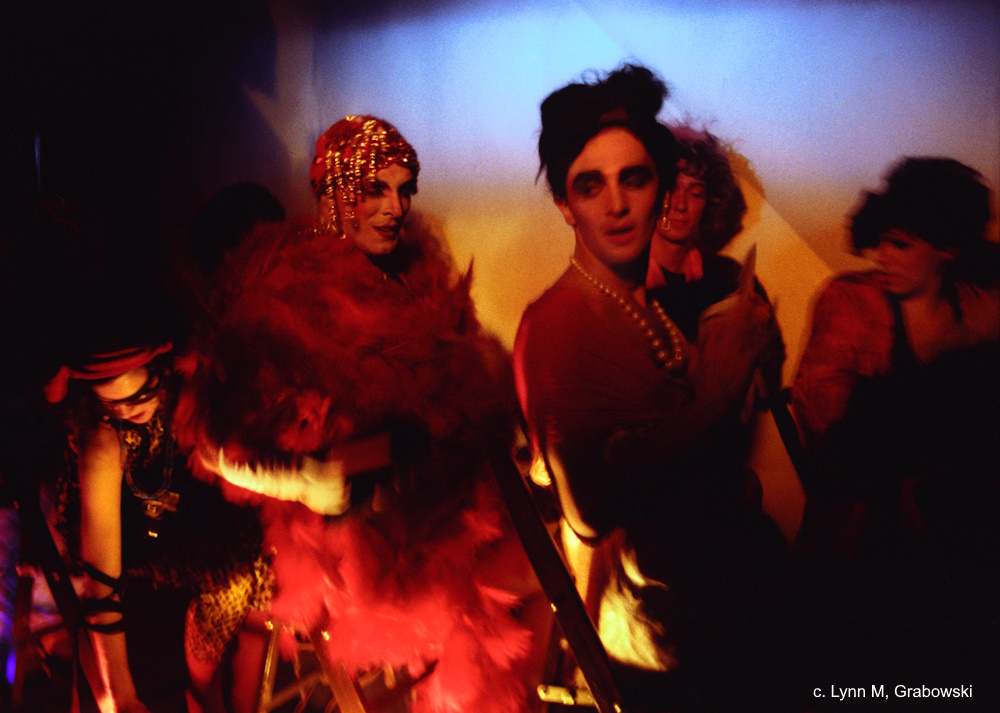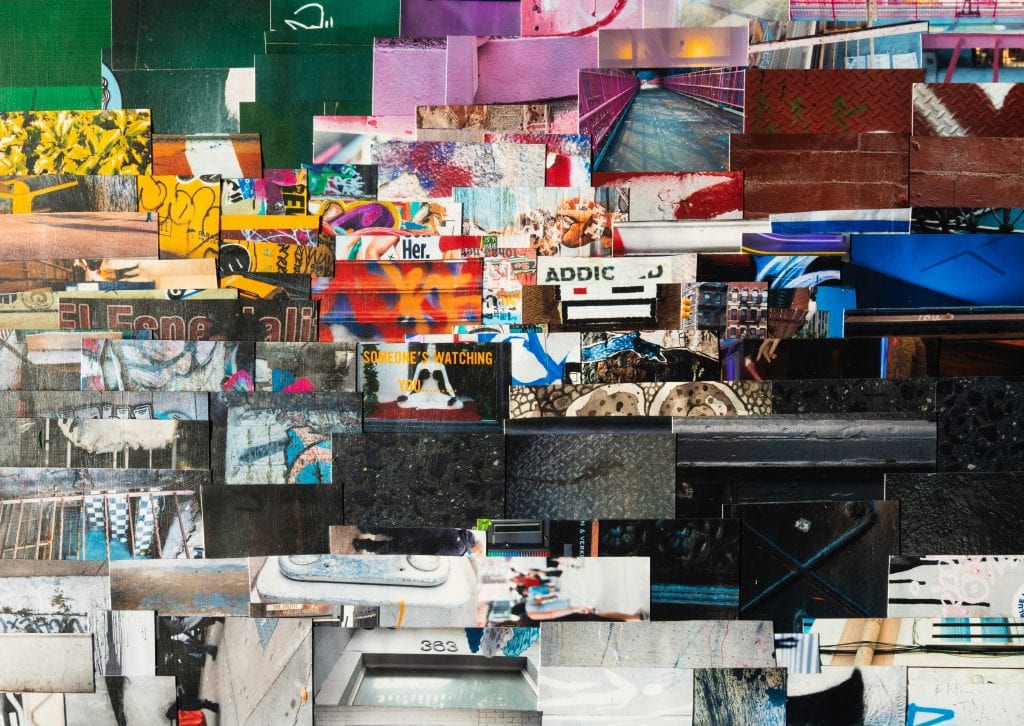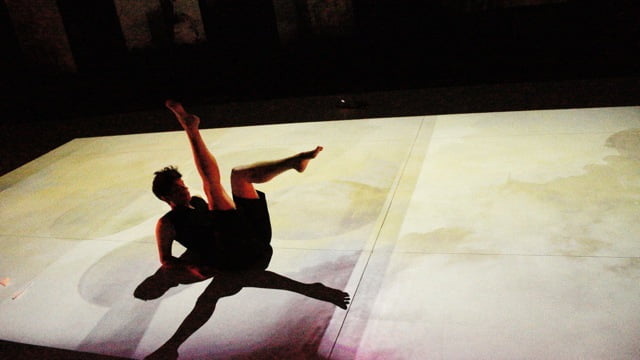
In this autobiographical performance work, an American woman and a German woman go on a blind date in Berlin. As they eat, drink, and begin to dance, they discover their mothers were both patients of a Nazi gynecologist war criminal: one tortured in medical eugenics atrocities, the other celebrated as a SS officer’s pregnant wife. As the two women explore one another’s bodies, they discover subterranean scars beneath the surfaces of their skin.
I created a suite of performance texts, photographs, and films at the sites of Nazi gynecologists unpunished for their medical atrocities. I collaborated with choreographer Alexx Shilling, composer Arthur Kell, and German poet Uljana Wolf to create a two-woman performance work with floor-based film projections, voice, text, field recordings, and live music. Our two figures in cocktail dresses move against hypnotic, abstracted floorscapes of medical offices juxtaposed against the debilitating emotional textures between the women.
The work considers how in a post-genocidal society the bodies of enemies sometimes meet as lovers first: a relationship later fractured by the tensions and invoked tragedies of a problematized history and cultural/ancestral heritage that they themselves did not choose. The work is an exploration of aftermath experience in which bodies and psyches are compulsively drawn together – and forced apart – by shock waves from a distant timespace.
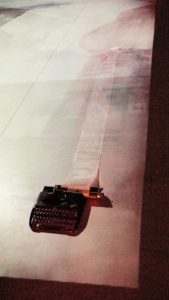
Charité
horsy schumann.
She and I smoke from a pale pink box. She evens up a blue pack of matches. Within my Dubonnet floats a centipede. Her manicure taps the glass—it wakes. We eat alongside the Charité Hospital, and the discomfort of such proximity demands distracting pleasures: the soft pillow on the chair, the candle between us, crisp black charms of a pepper shaker, the restaurant strung with café lights, katydids in the river reeds that soften the concrete, flat-bottomed boats pass by: laughter, beer, children.
imfried eberl.
All across the continent of summer, asparagus and potatoes pulled from the soil. Cows induced for the release of cream. To the south along the mountain’s toes, salt dragged scraping from its holes. Surprised by transport. And now my salad arrives, prostrate on its plate, exhausted.
rudolf lonauer.
Beside the Spree, a pair of pale eyes in the delicate face of a beauty. She hands me a cigarette, and I smoke three.
günther hennecke.
The legs that are currently attached to my body are not the ones with which I am familiar, and certainly have not been mine since birth. These new ones surprised me in this evening’s bath—an old, cracked porcelain affair. The water drained out past my ankles: mild, yellow, thin. These are some stony and nerveless things, poured into a mold, or else cast. Prosthetic, but unsubtle. Unlike the others: bony and serviceable and flushed and swelled and pumping with blood.
heinrich bunke.
She wears a yellow dress. Between the Charité and the Spree, my glass of Dubonnet. Within it floats a centipede, underbelly turned up to the sky. Clouds in Berlin unlike any others: huge, swollen, white. Where are the stringy pale ones, the vulnerable whisk of egg ones, the broken-feather ones of grey haze.
clara von hinklen.
In recent days, my old legs must have uncoupled from my hips, with a click of grease and a muscled wheeze. Separated at some station along my route. My arms and torso bound for investigation of atrocities–yet the embrittled remnant, allied in refusal, detaches on the platform in Leipzig. The tablecloth falls over my lap to hide the seam.
georg renno.
She is five foot ten. She agrees to a second glass of Dubonnet. She is kind, and uncomfortable. Had hoped for some happier kind of evening.
curt schmalenbach.
She has a faint blonde fur on the tops of her fingers, and it suspends a blur of dust in the candlelight. It is sweet. She is useless with euphemism. Like the others, she asks if my grandmother survived the experiments. Like the others, she has forgotten that her death would have made my birth improbable. Yes, I say with practice. And then, no.
klaus endruweit.
There is nothing to be accomplished by summoning a waiter and exchanging the glass of Dubonnet, by requesting a cleaner drink: in other glasses, other insects. Within this one a thousand legs spread open, doomed.
kurt borm.
Below the table, my underwear disguises a sharp bend of hips that now seem to snap instead of fold. There are feelings I used to have down there that I want to recognize again. Her eyelids bear blue paint. A luminous glaze, near incandescent in the haze of my smoke. Despite the readiness of her cosmetics, there is no dancing tonight at the Ballhaus in Mitte, with its varnish-crazed floors dehydrated by feet from last century. My former legs would have taken me away from this place. But these have rooted themselves, and refuse to move. She checks the tint of her lips in the hand mirror, opens them to flash light on bright teeth—a rasp of pink tongue across their white.
heinrich bunke.
She says hers was an easy birth. She arrived right after everything had begun to get better again: there were vegetables sprouting in the Tiergarten, different uniforms to be sewn with new patches and badges. And buildings were going up, with lipstick-red geraniums and hydraulic elevators. Babies were raw and welcome. Her mother was frightened and pleased. Dr. Aquilin Ullrich delivered her in what was widely recognized as a very easy birth.
frederick berner.
At some distance, I feel my legs twitch in Leipzig, in an imagined sanatorium for the mutinous legs of Jews who have returned for questioning. For the appendages that have refused to walk any farther through the mysterious anguish of ancestry. There is a strained gruel of sunshine and my rebel legs are blanketed in soft blue linens, tucked up on a chaise lounge. Pain and numbness, an unsavory combination alleviated by violins, chipped ice, and violets.
viktor brack.
She is patient with my questions, although her hair falls in her eyes when she lowers her face. When she looks up, it’s with a gift for statements of extrapolated fact. She believes Dr. Ullrich died without regrets. Before he re-invented himself, her mother’s eventual obstetrician hid from arrest and trial in the mines of the Saar. The killings of four thousand five hundred schizophrenics were easy deaths. The rocks in the shafts were difficult to pick apart, and he cared about his fingertips. After all that, attending births is no big deal. He was lighthearted with escape.
hans heinrich lammers.
Here I am, unraveling. Her navel, tied off with a killer’s string.
martin bormann.
Stretched out beside my legs in the Leipzig sanitarium—the thick-muscled, hairy legs of a man I met on a bus: his uncle the driver of a Hadamar gas van, his grandfather had been the boy who delivered the euthanized ashes of epileptics to their surviving parents. The seats on our bus were dark green plastic. I sat on my hands to still them. His grandfather had been a responsible boy, with soft hands known to be reliable, clasping the tiny urn on his bicycle as he shot across the cobblestones with a wobble. Accurate readings of street numbers meant a polite knock at the family’s door. The man’s nose blunted, a half-day growth of stubble at the base of his neck, a fresh tie and no freckles. At the stop, we didn’t transfer as neither of us wished to go farther.
philipp bouhler.
Beside the Spree, dinner arrives with fresh glasses and cloth napkins. She believes Dr. Ullrich died taking pride in his accomplishments. Across the street at the Charité Hospital are offices that once welcomed the gynecologists’ experiment: how best to prevent the imperfect from multiplying. Four hundred thousand proved the point: it is absolutely possible to eradicate hereditary diseases. Because depressed patients did not exhibit a will to live, Dr. Ullrich did not consider it murder. Everything salted to taste, then peppered. Seasonal asparagus with butter stains on the seam of my lap. He had no regrets. The children consigned to Chelm or to Brandenburg were then gassed. The first two hundred thousand were practice perfected. Tonight, she would have preferred to go dancing.
Artist Notes:
CHARITÉ is an autobiographical essay in which I go for a date in Berlin with a woman who was the patient of one of Nazi germany’s unprosecuted war criminal physicians. I travelled to Berlin for several years investigating the gynecological and neurological war criminal physicians who tortured ancestors and friends. I have epilepsy and am queer, and this physician was renouned for his torture, experiments, and murders of epileptics and queer people. Each of the section titles is the name of a war criminal physician who remains unprosecuted and went on to illustrious careers at German medical universities and hospitals. This essay is part of a collection in process about fascism, the far right, and the deviant/subhuman body.
First published in WITNESS magazine (http://witness.blackmountaininstitute.org/issues/volume-24-number-3-fall-2011/mercy-killing-action/) and then anthologized in QDA: Queer Disability Anthology (Squares and Rebels). https://www.amazon.com/QDA-Disability-Anthology-Raymond-Luczak/dp/1941960022
BIO:
Hailed as “universal and personal, comforting and jarring, ethereal and earthy” by Hyperallergic and “heady, euphoric, singular, surprising” by Publisher’s Weekly, artist and writer Quintan Ana Wikswo is recognized for adventurous transdisciplinary projects that integrate her original texts with photography, video installation, and performance. Her thirty-five projects tour widely, and are published, exhibited, performed, and toured at prominent institutions throughout Europe and the Americas.
Wikswo is the author of two collections of photographs and texts: The Hope Of Floating Has Carried Us This Far (Coffee House Press, 2015) and A Long Curving Scar Where The Heart Should Be (Stalking Horse Press, 2017). Her work is featured in museum exhibition catalogues Rituals Against Forgetting (Kehler Verlag), Group Therapy: Mental Distress in a Digital Age (F.A.C.T), and in anthologies including Emergency Index (Ugly Duckling Presse), Strange Attractors (University of Massachusettes Press), Procession for the Extracted (California College of the Arts), Queer Disasbility Anthology (Squares and Rebels), and One Blood (University of Alaska Press). Her writing has been published in Tin House, Guernica, Conjunctions, Gulf Coast, The Kenyon Review, New American Writing, Witness, the Denver Quarterly, Alaska Quarterly Review, and many other magazines.
She holds major fellowships from Creative Capital, the National Endowment for the Arts, the National Endowment for the Humanities, The Theo Westenberger Foundation, and the Center for Cultural Innovation. She has received multiple residencies at Montalvo, The Millay Colony, and Djerassi, and multiple residencies at Yaddo including The Pollock Krasner Residency. She is an active participant in NYC reading series including Joe’s Pub, (Le) Poisson Rouge, Dixon Place, Bowery Poetry, St. Marks, and maintains a lively visiting artist practice at NYU, CUNY, Colgate College, California College of Arts, California State University, Santa Fe University of Art and Design, and others.
She has received multiple critically-acclaimed solo museum exhibitions in New York City and Berlin, including The Berlin Jewish Museum, the Jewish Museum Munich, the Smithsonian-affiliated Center for Jewish History/Yeshiva University Museum, and her work has been featured in several major museum and gallery exhibitions, including the Museum of Modern Art (France), The Ronald Feldman Gallery (NYC), the Musee des Moulages (France), and the Foundation for Art and Technology F.A.C.T. (UK), where her work was reviewed in The Guardian as a Special Selection. Her photographs are held in the permanent collections and archives of the Brooklyn Museum of Art, Berlin Jewish Museum, the Jewish Museum Munich, and People For the American Way as well as other museum and institutional collections throughout Europe and the United States.
Her collaborative and solo performance video installation work appears regularly at Museum of Jurassic Technology, (Le) Poisson Rouge, St. Mark’s Church, Incubator Arts Project, Dixon Place, Bowery Poetry Club, and more.
She is the recipient of fellowships from the Creative Capital Foundation, National Endowment for the Arts, Pollock Krasner Foundation, Yaddo, Durfee, Center for Cultural Innovation, and Theo Westenberger Estate.
Her practice is located in New York City and Santa Fe.
